Synchrony Bundle
Who Are Synchrony's Customers?
In the ever-evolving financial services landscape, understanding Synchrony SWOT Analysis is crucial for success. Synchrony, a leading financial services provider, must deeply understand its customer base to thrive. This understanding is not just about knowing who they are but also anticipating their future needs and behaviors.
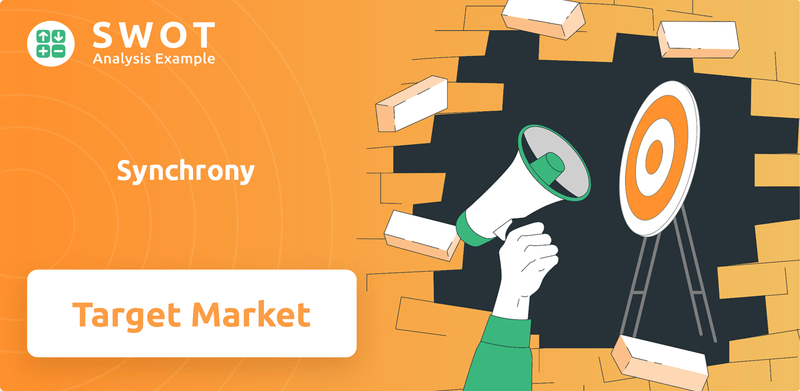
This exploration into the Synchrony target market and customer demographics will provide valuable insights. We'll delve into the Synchrony company's strategic approach to market segmentation, examining how it leverages consumer data to tailor its offerings. Analyzing Synchrony customer demographics analysis and identifying Synchrony target market identification will reveal the company's customer profile and how it aims to capture and retain its ideal customer.
Who Are Synchrony’s Main Customers?
Understanding the Synchrony company's customer base involves examining its primary customer segments. The company operates mainly in a Business-to-Business-to-Consumer (B2B2C) model, which means it serves consumers indirectly through partnerships with various businesses. These partnerships allow Synchrony to offer financing options to consumers at the point of sale and beyond.
The core customer demographics for Synchrony often include individuals seeking financing for significant purchases. These purchases typically fall within sectors like retail, home improvement, automotive, and healthcare. While specific demographics vary depending on the partner and the product, a significant portion of the customer base consists of middle-income households and individuals across various age groups. This includes younger adults establishing credit and older adults managing larger purchases.
Synchrony's target market is diverse, encompassing both consumers (B2C) and businesses (B2B). The B2B segment includes major national retailers, local merchants, and healthcare providers that utilize Synchrony's platforms to offer financing to their customers. The company's largest revenue share generally comes from private label credit card programs, emphasizing consumer financing at the point of sale.
Synchrony segments its market to target specific consumer needs. This includes those seeking financing for retail purchases, home improvements, and healthcare services. The company's approach allows it to tailor its offerings to different customer segments effectively.
Synchrony's customer base spans a broad age range, from young adults to seniors. Income levels also vary, with a focus on middle-income households. The company's products, such as CareCredit, cater to diverse financial needs within the healthcare sector.
Synchrony expands its reach through partnerships with retailers and healthcare providers. This strategy provides financing solutions directly to consumers. The company continues to broaden its offerings, including general-purpose credit cards, to attract a wider demographic.
Synchrony strategically focuses on digitally native segments and those with growing healthcare expenditures. This shift is evident in its digital financing options and healthcare-specific products. This focus aligns with evolving consumer behaviors and market trends.
Synchrony's customer base includes a mix of ages and income levels. The company's focus on digital and healthcare financing indicates an understanding of evolving consumer needs. The company's strategy is to offer financial services to a diverse group of customers.
- Middle-income households form a significant part of the customer base.
- Various age groups, from young adults to seniors, utilize Synchrony's services.
- The company's partnerships with retailers and healthcare providers expand its reach.
- Synchrony is expanding its offerings to include general-purpose credit cards.
Synchrony SWOT Analysis
- Complete SWOT Breakdown
- Fully Customizable
- Editable in Excel & Word
- Professional Formatting
- Investor-Ready Format
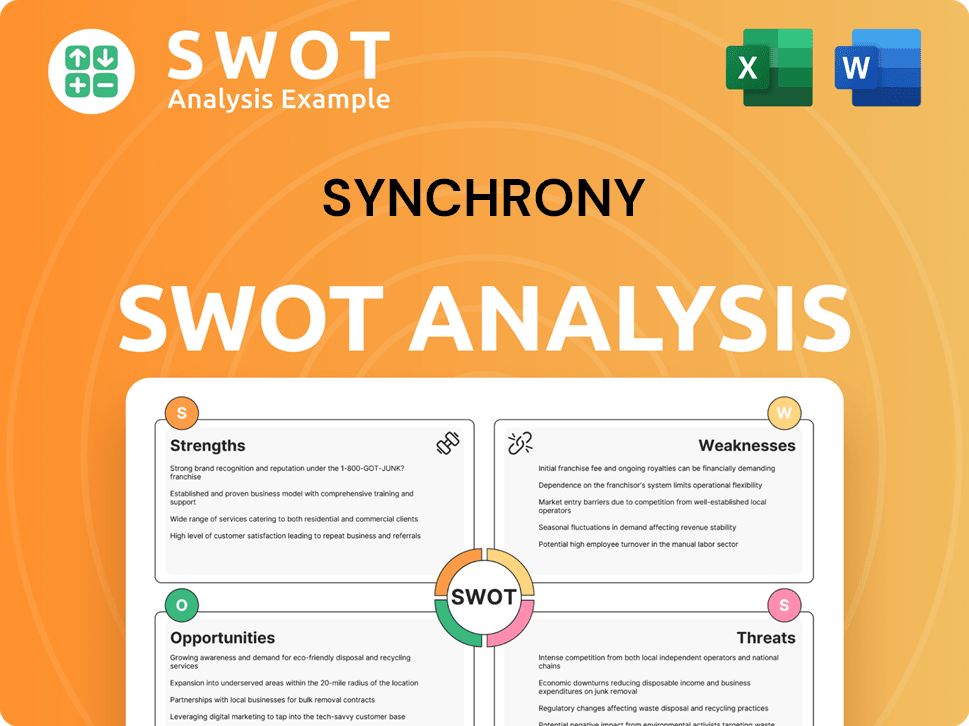
What Do Synchrony’s Customers Want?
Understanding the customer needs and preferences is crucial for the success of any financial institution. For the Synchrony company, this involves a deep dive into the motivations and behaviors of its diverse customer base. The Synchrony target market is broad, encompassing various demographics and financial profiles, all united by the need for flexible financing solutions.
Customer demographics and their preferences are key drivers for product development and marketing strategies. By analyzing these factors, the company can tailor its offerings to meet specific needs, enhancing customer satisfaction and loyalty. This approach is essential in a competitive financial services landscape.
Synchrony's customers are primarily driven by the need for flexible payment options and access to credit for significant purchases. Their purchasing behaviors often involve financing larger ticket items, from furniture and electronics to medical treatments and automotive repairs. Decision-making criteria frequently revolve around interest rates, promotional offers, ease of application, and the perceived value of the credit program offered by the merchant.
Customers seek payment options that allow them to manage their finances effectively. This includes installment plans and deferred interest offers. These options provide financial flexibility for large purchases.
Access to credit is essential for financing significant purchases. Customers need credit cards for various expenses, from home improvements to healthcare. This access is a core offering.
Customers prefer easy-to-use account management tools. This includes online portals and mobile apps for managing accounts and making payments. Convenience is a key factor.
Competitive interest rates and promotional offers are significant decision-making factors. Customers compare rates and look for benefits like deferred interest. These offers attract new customers.
A streamlined application process is crucial. Customers want a quick and straightforward way to apply for credit. This reduces friction and increases acceptance rates.
The perceived value of the credit program offered by the merchant is important. Customers consider the benefits, rewards, and overall value proposition. This value drives loyalty.
Product usage patterns indicate a reliance on credit lines for both planned and unplanned expenditures, with a strong preference for digital account management and payment options. Loyalty factors are often tied to the perceived value of the credit program, positive customer service experiences, and the continued availability of financing for future purchases within their preferred merchant networks. For deeper insights into how Synchrony approaches its market, consider reading about the Marketing Strategy of Synchrony.
Customers often face challenges with managing multiple credit accounts and understanding complex terms. Synchrony addresses these issues through streamlined application processes and user-friendly online portals. The company's focus is on simplifying the customer experience.
- Streamlined Applications: Simplified processes make it easier for customers to apply for credit.
- User-Friendly Portals: Online and mobile platforms provide easy access to account information.
- Mobile Applications: Mobile apps offer account management and payment options on the go.
- Promotional Financing: Offers like the Synchrony HOME Credit Card provide flexible payment options.
Synchrony PESTLE Analysis
- Covers All 6 PESTLE Categories
- No Research Needed – Save Hours of Work
- Built by Experts, Trusted by Consultants
- Instant Download, Ready to Use
- 100% Editable, Fully Customizable
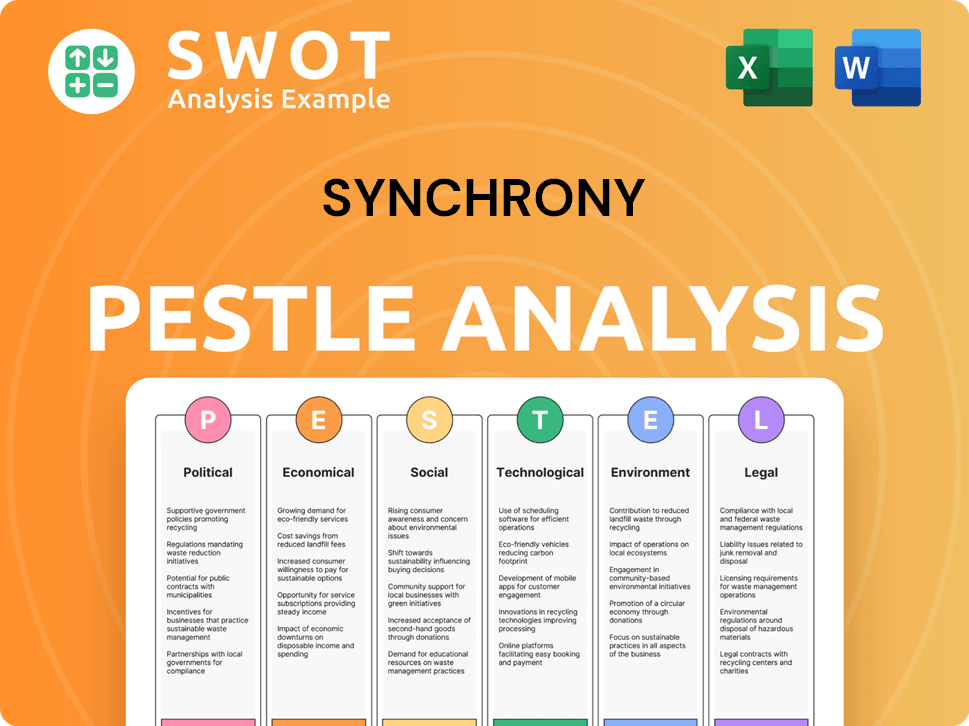
Where does Synchrony operate?
The geographical market presence of the Synchrony company is predominantly within the United States. The company strategically focuses its operations domestically, leveraging its strong market share in private label credit cards and consumer financing. This concentration allows for a deep understanding and tailored approach to the U.S. market, optimizing its services for a diverse customer base.
Synchrony's footprint spans across all U.S. states, with a significant presence in densely populated areas and regions with robust retail and healthcare infrastructure. The company's success is closely tied to its partnerships with major national retailers and healthcare providers, ensuring its credit products are widely accessible. This widespread availability is a key factor in reaching its target market and maintaining a competitive edge in the financial services sector.
The company's approach to managing regional differences in customer demographics, preferences, and buying power is largely through the localized strategies of its partners. Synchrony provides tailored analytics and support to these partners, enabling them to optimize their credit programs for their specific regional customer bases. This collaborative model allows for effective market segmentation and targeted offerings, enhancing customer engagement and satisfaction. For more insights, explore the Growth Strategy of Synchrony.
Synchrony's primary market is the United States, where it holds a significant position in the financial services industry. Its strategy concentrates on deepening its presence and expanding offerings within the domestic market. This focus allows for efficient resource allocation and a better understanding of the local consumer data.
Synchrony relies on its partners' localized strategies to manage regional differences in customer demographics. This approach enables the company to tailor its offerings to specific markets. The company provides partners with tailored analytics and support to optimize their credit programs.
While Synchrony's core focus remains the U.S. market, it has historically engaged in limited international operations or partnerships. The company's strategic emphasis is on expanding its offerings within the domestic market. This strategic choice allows for greater control and efficiency in serving its primary target market.
Recent strategies have focused on expanding into new verticals within the U.S., such as pet care and powersports. This diversification helps increase its customer base and revenue streams. The company's ability to adapt to changing market demands is a key factor in its success.
Synchrony Business Model Canvas
- Complete 9-Block Business Model Canvas
- Effortlessly Communicate Your Business Strategy
- Investor-Ready BMC Format
- 100% Editable and Customizable
- Clear and Structured Layout
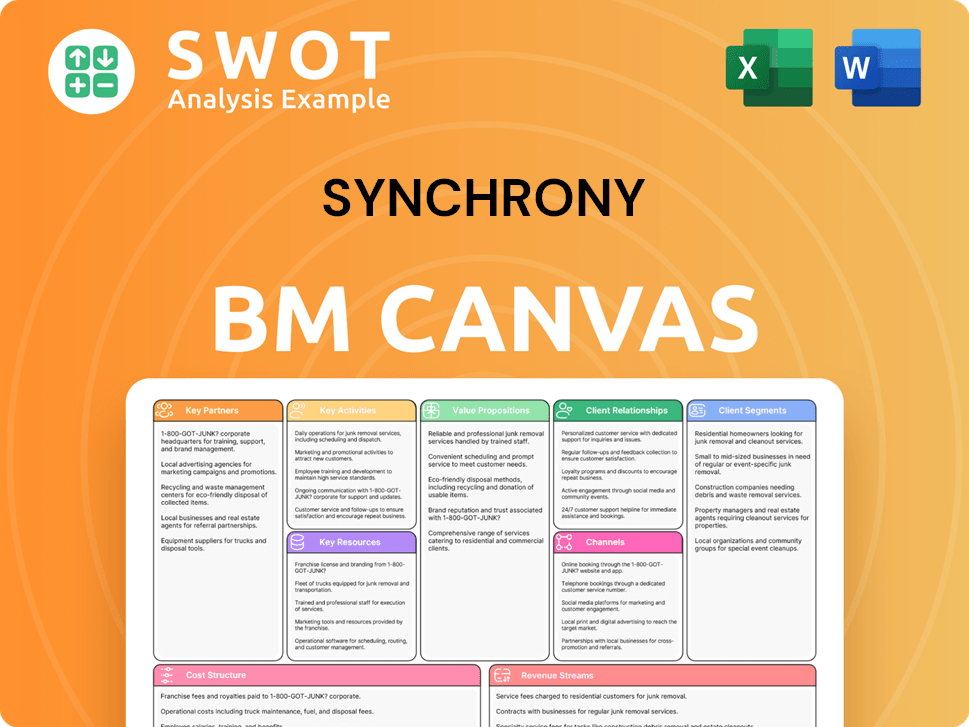
How Does Synchrony Win & Keep Customers?
The acquisition and retention strategies of the company are deeply rooted in its business model, which heavily relies on partnerships. This approach allows the company to reach a broad customer base through established retail, healthcare, and automotive networks. The core strategy focuses on offering private label credit cards and financing options at the point of sale, effectively integrating the company's financial products into the customer's purchasing journey.
Digital marketing is a key driver for customer acquisition, utilizing online applications, targeted promotions through partner platforms, and digital advertising campaigns. Traditional marketing methods, such as in-store signage and direct mail, also play a supporting role. Furthermore, the company employs referral programs and direct-to-consumer marketing for its general-purpose credit cards, broadening its reach beyond its partner network. This multi-faceted approach is designed to capture a diverse customer base while providing a seamless application and onboarding experience.
Customer data and CRM systems are fundamental to the company's strategy. Advanced analytics are employed to segment customers and understand their spending habits. This data-driven approach allows for personalized offers, targeted campaigns, and enhanced customer experiences, such as special financing promotions or credit line increases. Loyalty programs, often integrated with partners' initiatives, add value for customers, enhancing retention and encouraging repeat usage. The company's focus on digital engagement and personalized experiences is aimed at improving customer satisfaction and reducing churn rates.
The company primarily acquires customers through its extensive network of partners in retail, healthcare, and automotive sectors. These partners facilitate the offering of private label credit cards and financing options at the point of sale. This B2B2C model allows the company to leverage its partners' sales processes and marketing efforts for customer acquisition.
Digital marketing plays a crucial role, with online applications, targeted promotions, and digital advertising campaigns. Traditional marketing methods, such as in-store signage and direct mail, also support acquisition efforts. These diverse strategies help in reaching a broad customer base.
The company utilizes customer data and CRM systems to segment customers and understand their spending patterns. This data-driven approach enables targeted campaigns, such as special financing promotions and personalized credit line increases. The focus on personalization drives customer engagement and retention.
Loyalty programs are often integrated into partners' initiatives to enhance customer value. After-sales service is a critical retention tool, with a focus on providing excellent customer support through various channels. These strategies are designed to build customer loyalty and encourage repeat usage.
The company employs market segmentation to understand its customer base better. This involves analyzing various factors such as spending patterns, demographics, and financial behavior. This segmentation allows for the creation of targeted marketing campaigns.
The company gathers customer data from multiple sources, including application forms, transaction history, and partner data. This information is crucial for understanding customer behavior and preferences. The use of this data helps the company tailor its offerings.
The company focuses on digital engagement through enhanced mobile app functionalities and online self-service tools. Proactive communication regarding account management and promotional offers is also a key strategy. These digital initiatives aim to improve customer satisfaction and retention.
The introduction of general-purpose credit cards represents a diversification of the acquisition strategy. This allows the company to directly acquire customers outside its partner network. This expansion helps the company broaden its customer base and market reach.
The company conducts customer behavior analysis to understand spending habits, preferences, and financial needs. This analysis informs the development of targeted marketing campaigns and personalized offers. Understanding customer behavior is essential for retention.
The company identifies its target market through detailed market research and analysis of customer demographics. This involves understanding the needs and preferences of different customer segments. This helps the company tailor its products and services.
The company's acquisition and retention strategies are multi-faceted, leveraging its B2B2C model and digital channels. The focus is on providing a seamless customer experience and building long-term relationships. Understanding the brief history of the company is important.
- Partnerships: Leveraging partnerships with retailers, healthcare providers, and automotive businesses.
- Digital Marketing: Utilizing online applications, targeted promotions, and digital advertising.
- Data Analytics: Employing customer data and CRM systems for segmentation and personalization.
- Loyalty Programs: Integrating loyalty initiatives to enhance customer value.
- Customer Service: Providing excellent after-sales service through various channels.
Synchrony Porter's Five Forces Analysis
- Covers All 5 Competitive Forces in Detail
- Structured for Consultants, Students, and Founders
- 100% Editable in Microsoft Word & Excel
- Instant Digital Download – Use Immediately
- Compatible with Mac & PC – Fully Unlocked
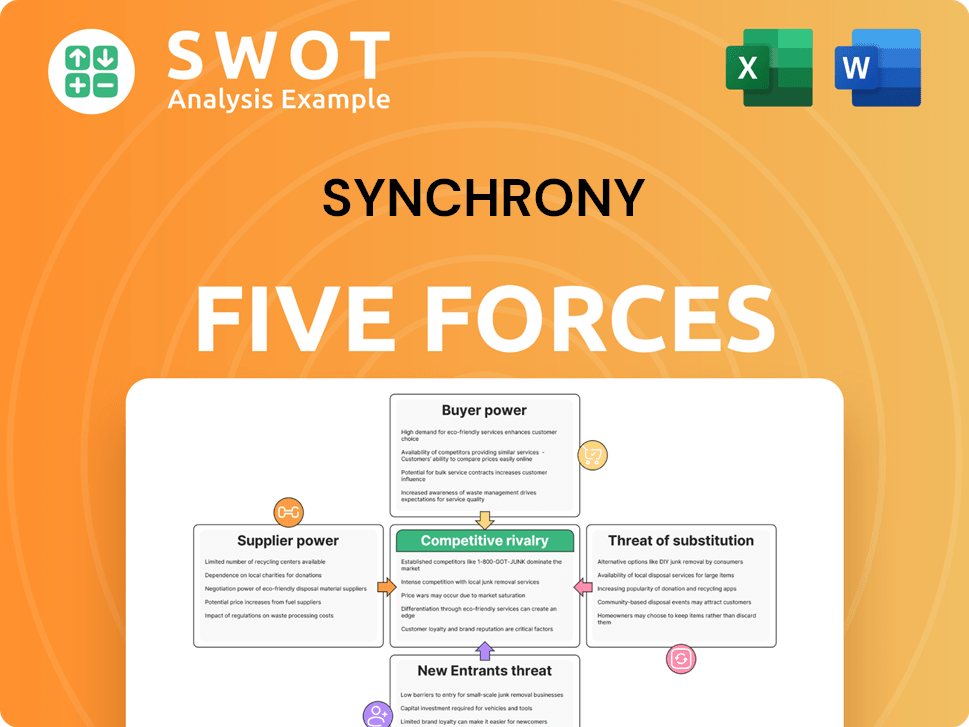
Related Blogs
- What are Mission Vision & Core Values of Synchrony Company?
- What is Competitive Landscape of Synchrony Company?
- What is Growth Strategy and Future Prospects of Synchrony Company?
- How Does Synchrony Company Work?
- What is Sales and Marketing Strategy of Synchrony Company?
- What is Brief History of Synchrony Company?
- Who Owns Synchrony Company?
Disclaimer
All information, articles, and product details provided on this website are for general informational and educational purposes only. We do not claim any ownership over, nor do we intend to infringe upon, any trademarks, copyrights, logos, brand names, or other intellectual property mentioned or depicted on this site. Such intellectual property remains the property of its respective owners, and any references here are made solely for identification or informational purposes, without implying any affiliation, endorsement, or partnership.
We make no representations or warranties, express or implied, regarding the accuracy, completeness, or suitability of any content or products presented. Nothing on this website should be construed as legal, tax, investment, financial, medical, or other professional advice. In addition, no part of this site—including articles or product references—constitutes a solicitation, recommendation, endorsement, advertisement, or offer to buy or sell any securities, franchises, or other financial instruments, particularly in jurisdictions where such activity would be unlawful.
All content is of a general nature and may not address the specific circumstances of any individual or entity. It is not a substitute for professional advice or services. Any actions you take based on the information provided here are strictly at your own risk. You accept full responsibility for any decisions or outcomes arising from your use of this website and agree to release us from any liability in connection with your use of, or reliance upon, the content or products found herein.